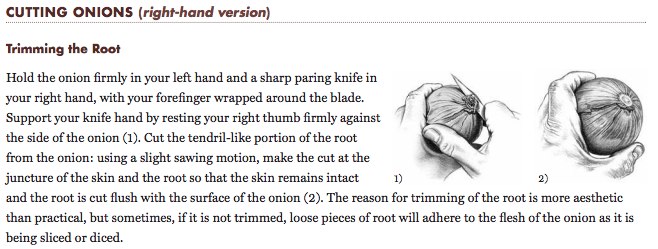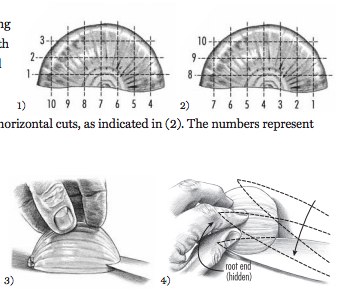Knife Skills Illustrated: A User’s Manual
How to cut correctly
I have used this fantastic reference book for about three months and it has greatly improved my time in the kitchen. Cooking consists mainly of three basic skills: heating things, putting things together (mixing) and taking things apart (cutting). This book is focused exclusively on the last set of skills.
Why are good knife skills so important? They allow you to cut food without hurting yourself. Also, as the author explains, “you are able to cut it into evenly sized pieces that will all cook at the same rate.” In many cases, you can reduce waste by using a well-thought out cutting technique. In practice, the book has also improved my efficiency in the kitchen, since I can now dice an onion in about a dozen or so deliberate strokes of the knife, rather than chopping haphazardly until I get it into roughly the shape I want it in. There are also aesthetic advantages–good presentation is easier to achieve with consistently cut pieces of food. Finally, as the author notes: “With good knife skills, cooking becomes fun.” I couldn’t agree more.
The book walks readers through the process of selecting the proper tool for the job and illustrates the pros and cons of various shapes and blade materials for various tasks. After getting familiar with the two basic grips (yes, you have probably been doing it wrong all your life), knife care and cutting boards are covered briefly and then the real fun begins.
The subsequent chapters explain the best way to cut a wide variety of common vegetables, fruits, meats, fish and poultry. Explanations are clear and concise and are accompanied by beautiful hand-drawn illustrations in both right and left-handed versions. In many cases, multiple techniques are covered.
Much of this information can be accessed in Youtube videos or other online resources. However, I find this book to be far superior for several reasons. First, the book clearly spells out each step in the process, together with an illustration from an ideal angle. With online videos, the steps often run together, forcing you to start/stop and rewind the video in order to completely understand the process. Also, videos are often shot facing the chef, who narrates the process along the way, making it difficult to see what is happening. The written explanations also often contain much more detailed explanations than would be possible in a video voice-over. Critically, I can spread the book out in front of me in the kitchen while I attempt the technique that I am learning. It is easy to look forward or back a step and then pick up where I left off. This is potentially workable using videos on an iPad, but in practice the book is much more convenient. All of the information in the book is consistent in terms of presentation and quality. With online resources, you never know what you are going to get.
Last but not least, it’s very satisfying to pull the book down from the shelf and thumb through it during a spare moment, enjoying the artwork and layout. It sometimes inspires me to attempt a new dish that I would not otherwise have thought of. This book is a cool tool that is also a beautiful object in its own right.
03/23/12Excerpt
*

*

Dicing an onion, the traditional method.
(For those interested, Peter Hertzmann has made a sample chapter covering how to properly chop onions available in PDF-form here. — editors)
Knife Skills Illustrated: A User's Manual Peter Hertzmann 2007, 256 pages $20






